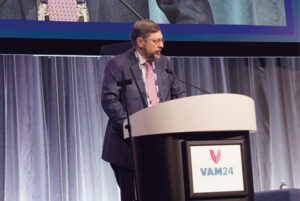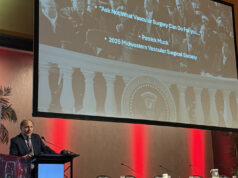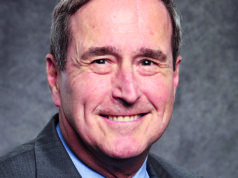
Many attending the 2024 Vascular Annual Meeting (VAM; June 19–22) might have been unaware of the early life of 2023–24 Society for Vascular Surgery (SVS) President Joseph Mills, MD. Amongst an intrepid childhood following his father’s career as a dentist, incoming SVS President Matthew Eagleton, MD, noted as he introduced Mills to give the 2024 Presidential Address in Chicago, Mills had spent a portion of his formative years growing up on the Navajo reservation in Arizona. There, an elementary-school-aged Mills was one of only two non-Native American children in his class.
That period of the Baylor School of Medicine in Houston professor and chief of vascular surgery planted a lifelong respect for—and interest in—Native American culture. It also led him down a path of service, following in the footsteps of his father before him, who had landed on the Navajo reservation as part of a public service commitment.
It cast a compelling backdrop to the core message behind Mills’ address in Chicago.
Mills issued a rallying call steeped in classical history and decades of collected vascular surgery wisdom with a singular aim: to overcome “unrest” and to drive forward vascular care with a broad approach to diversity.
Mills variously tackled the consolidation of medicine into ever-larger for-profit enterprises, the stresses inherent within a body of people such as the SVS, and the strong political position taken by the Society over appropriate care during his term of office.
He cast some of the conundrums facing the specialty thus: “Tension is an everyday consideration in life,” said Mills. “Tension and shear stress in arteries modulate wall thickness and vessel diameter. Tension is a fundamental aspect in each of our lives as well as in society at large.”
Examples include tension between physicians and payors, Mills continued, “tensions between physicians and the healthcare system, and tensions between alternative techniques, societies and specialties and even within societies.”
He invoked the democratic ideals of the ancient Greeks and how these principles drive collected interests in societies. “The poet and pre-Socratic philosopher Xenophanes stated that justice is a form of ‘tension-in-action,’” he said. “So how do we mitigate tension, particularly within the Society for Vascular Surgery, as we are simply a microcosm of society at large?”
Mills homed in on the necessity of a more diverse SVS Executive Board (EB). The EB, he explained, has expanded to include officers who are either self-nominated or nominated by others and then selected by the Nominating Committee and the 37-member Strategic Board of Directors to add diversity of perspective and additional competencies.
But by greater diversity, said Mills, he means more than the obvious markers such as gender and skin color. Diversity is multifactorial and must include diversity of perspective and cognitive diversity, he continued. “Alternate perspectives and points of view must be included for a society or group to make the best decisions. As my long-time friend and vascular brother Spence Taylor used to say, if you go to see the brown shoe salesman, you are going to get a pair of brown shoes. Or, to paraphrase Atticus Finch in To Kill a Mockingbird, you never really understand a person until you consider it from their point of view and walk in their shoes.”
Mills started his vascular surgery career at Wilford Hall USAF Medical Center in San Antonio, Texas, there beginning the service-minded approach instilled by his father.
Later in his career, Mills returned to the scene of those early experiences in Arizona, where he helped lead efforts to establish a respected multidisciplinary limb salvage group known as SALSA, or the Southern Arizona Limb Salvage Alliance—a toe and flow model that paved a path for cross-specialty collaboration.
“I would propose that the broad disparities in vascular research and training that have been widely written about are fundamentally due to lack of inclusion and diversity among practitioners and investigators, whether one looks at disparities related to gender, people of different skin colors, or people living in rural environments. In fact, nearly all vascular diseases that have been studied, as well as the majority of device trials, have failed to sufficiently include all members of our society,” he said.
In tandem with the diversity message came a tone pointing toward the necessity of collaboration. “In line with building coalitions in a crisis, major efforts are being made to engage other organizations when they are in alignment with our goals and objectives to promote our specialty for improving the care of patients with vascular disease,” Mills related.
“We are a small group, far too small to be splintered or fragmented,” he said, finishing with a favorite maxim: “If you want to go fast, go alone. If you want to go far go together.”
He added: “It is unquestionable that giant leaps have been made in our field by many individual pioneers and innovators, but the way we reach the goal of optimizing our clinical effectiveness and improving care for all people with vascular disease, is to work together. All major individual accomplishments need to be translated into work that we can all do to provide better care for our patients.”











